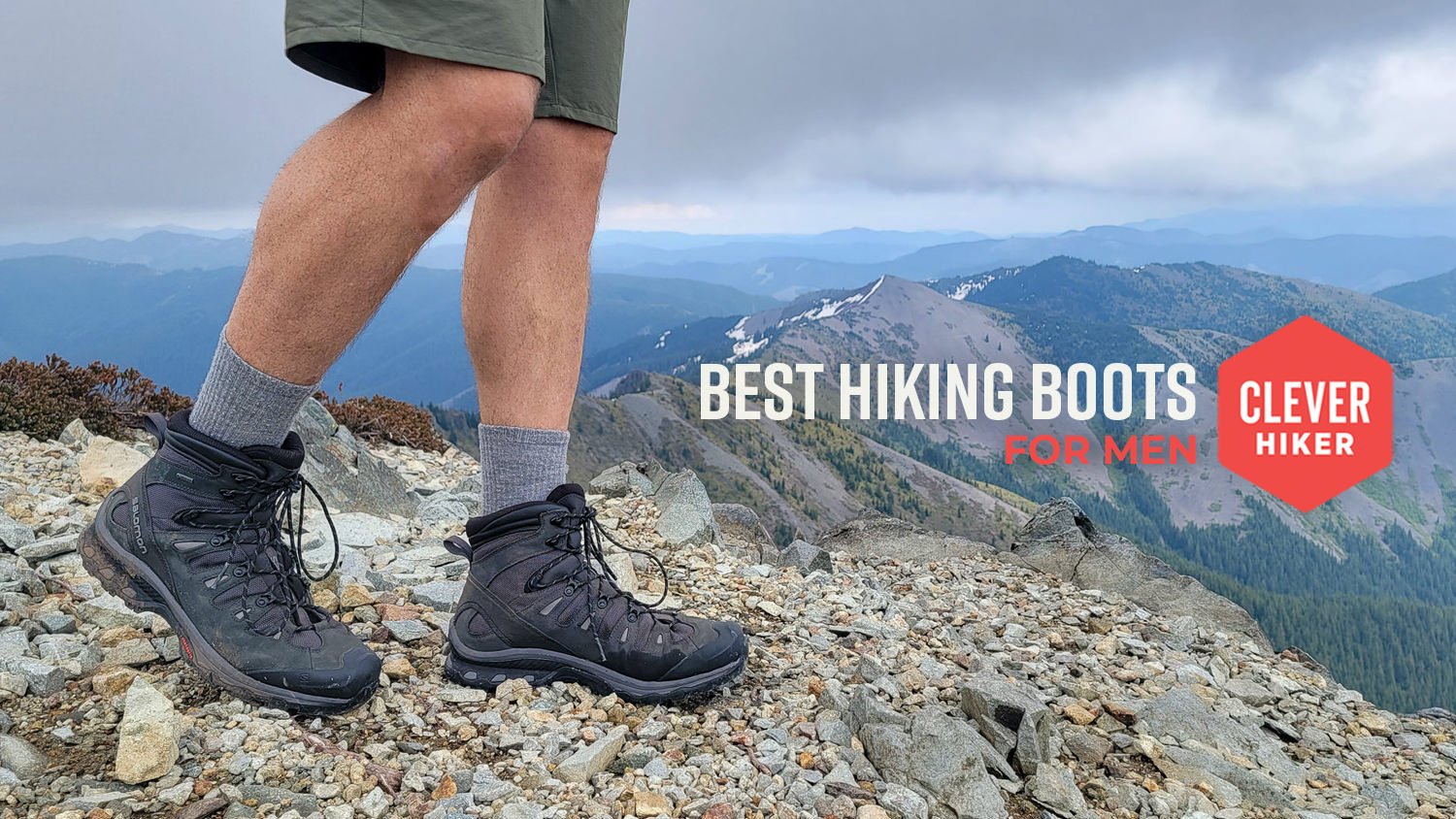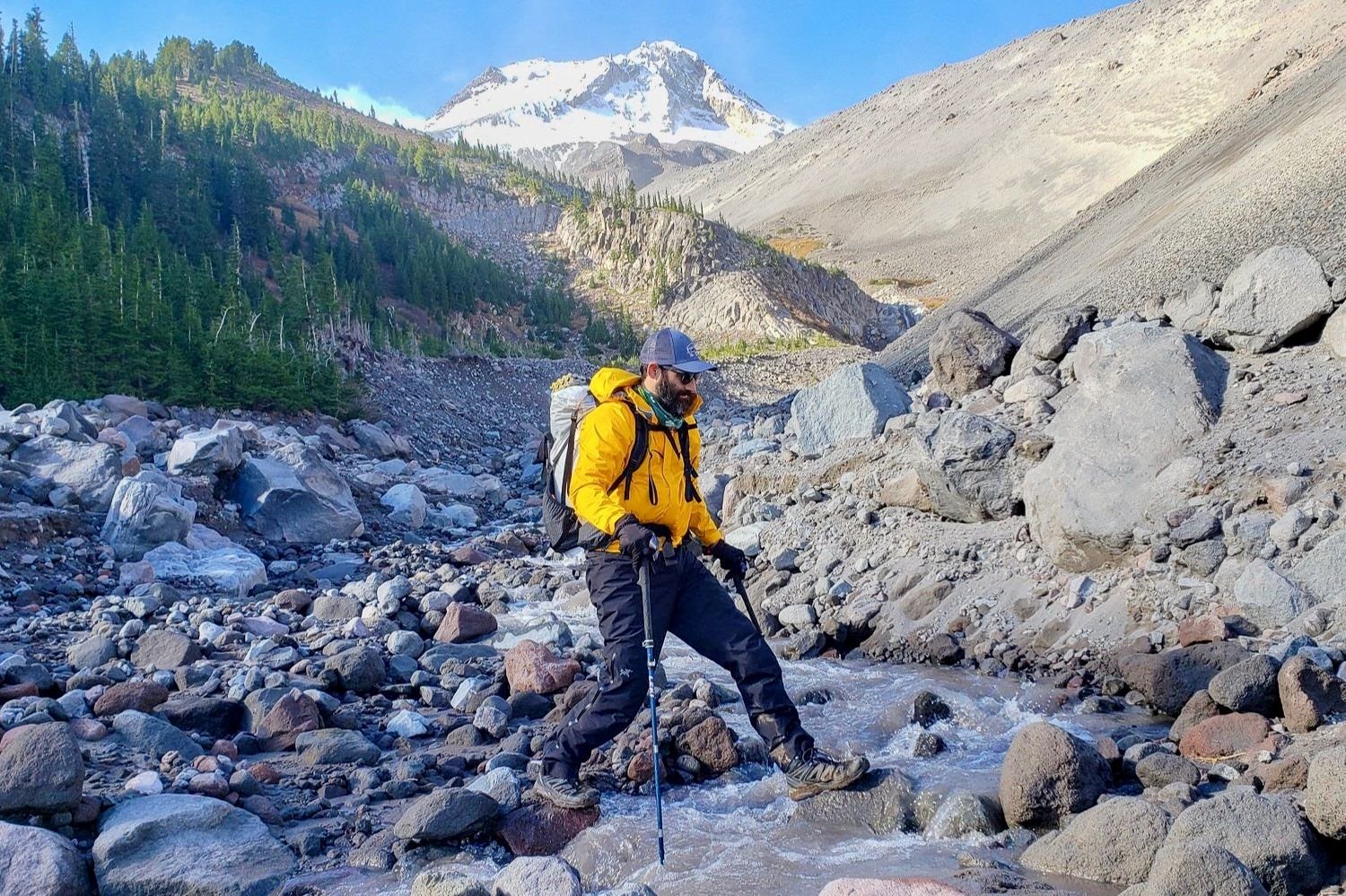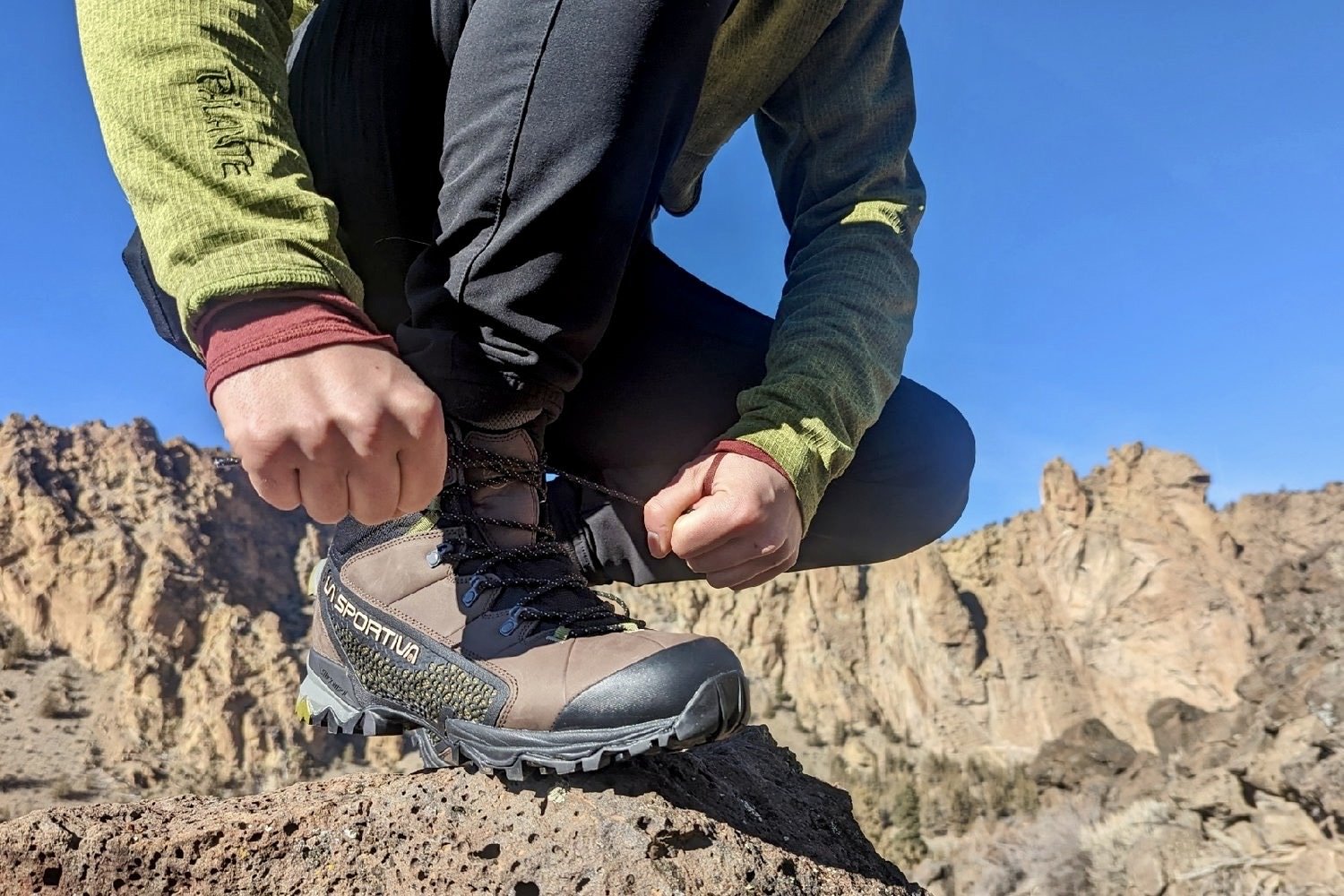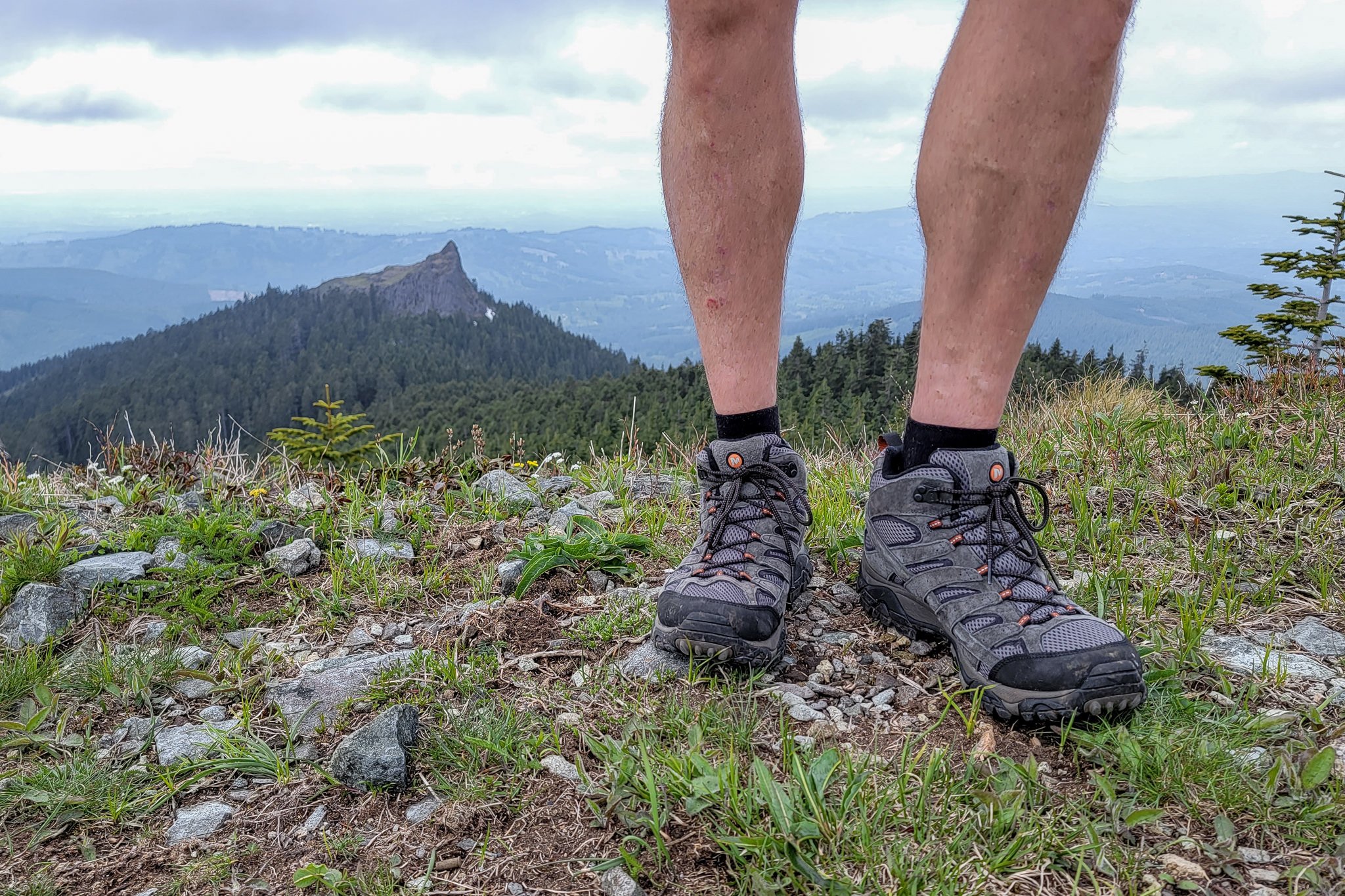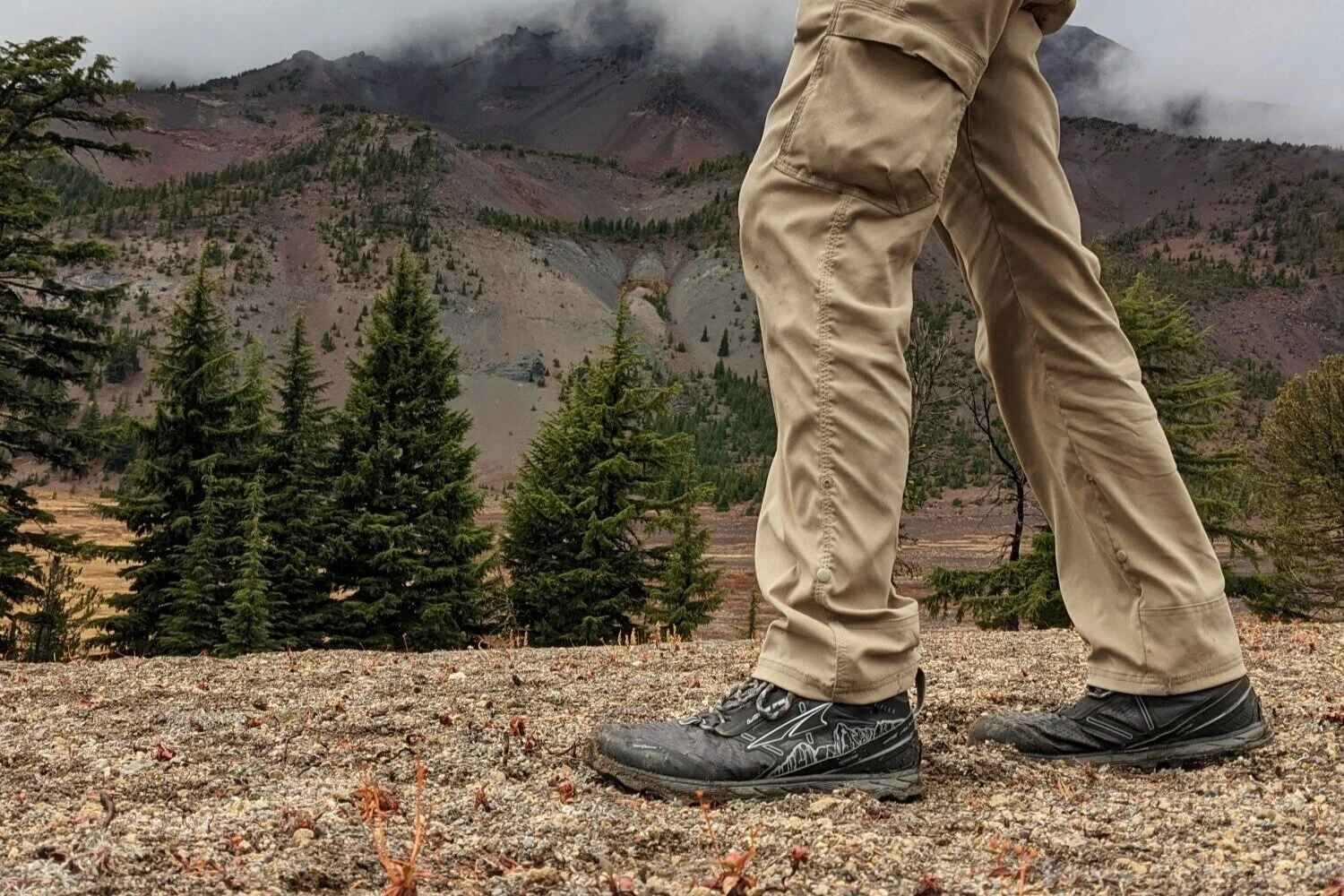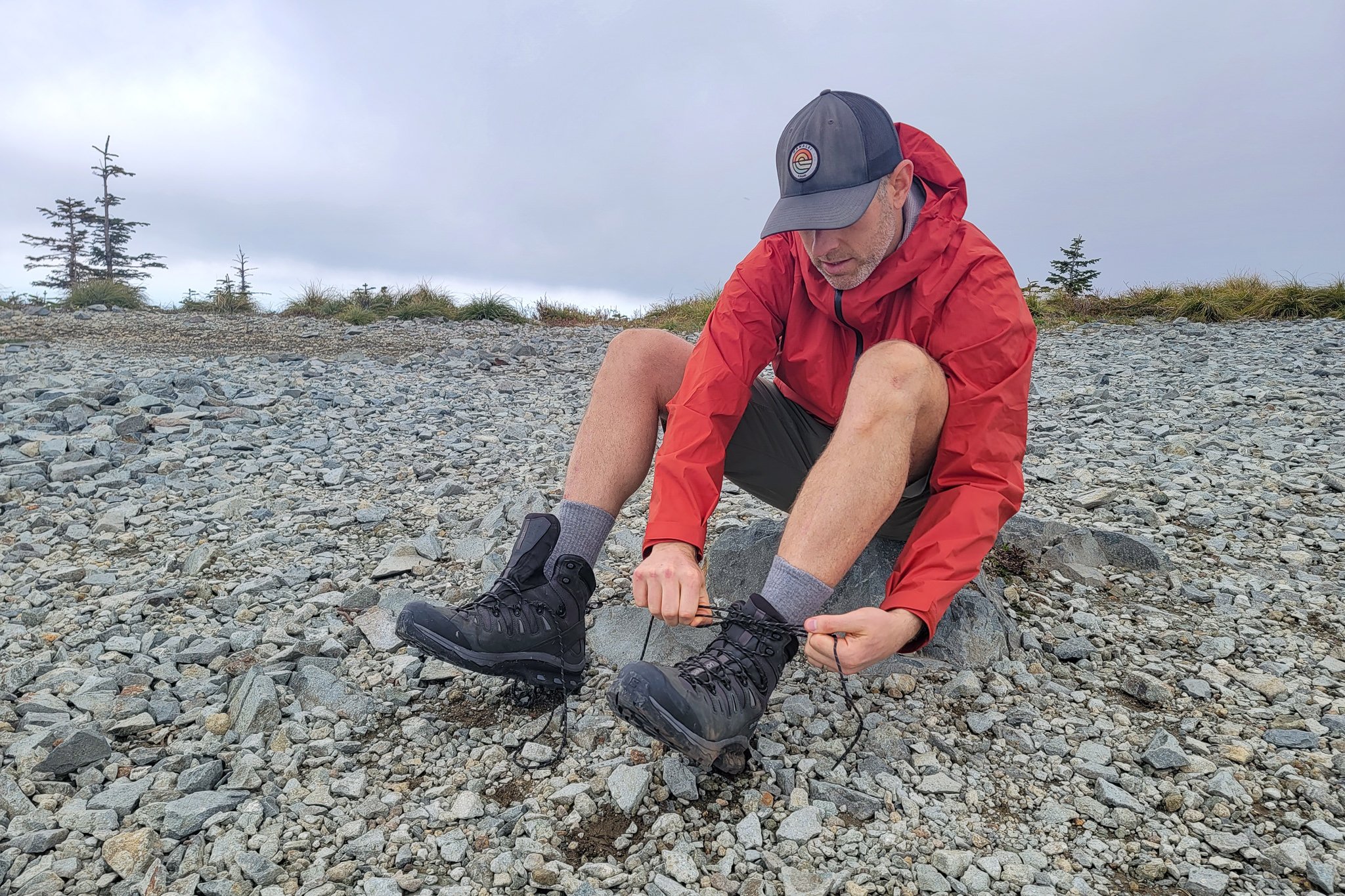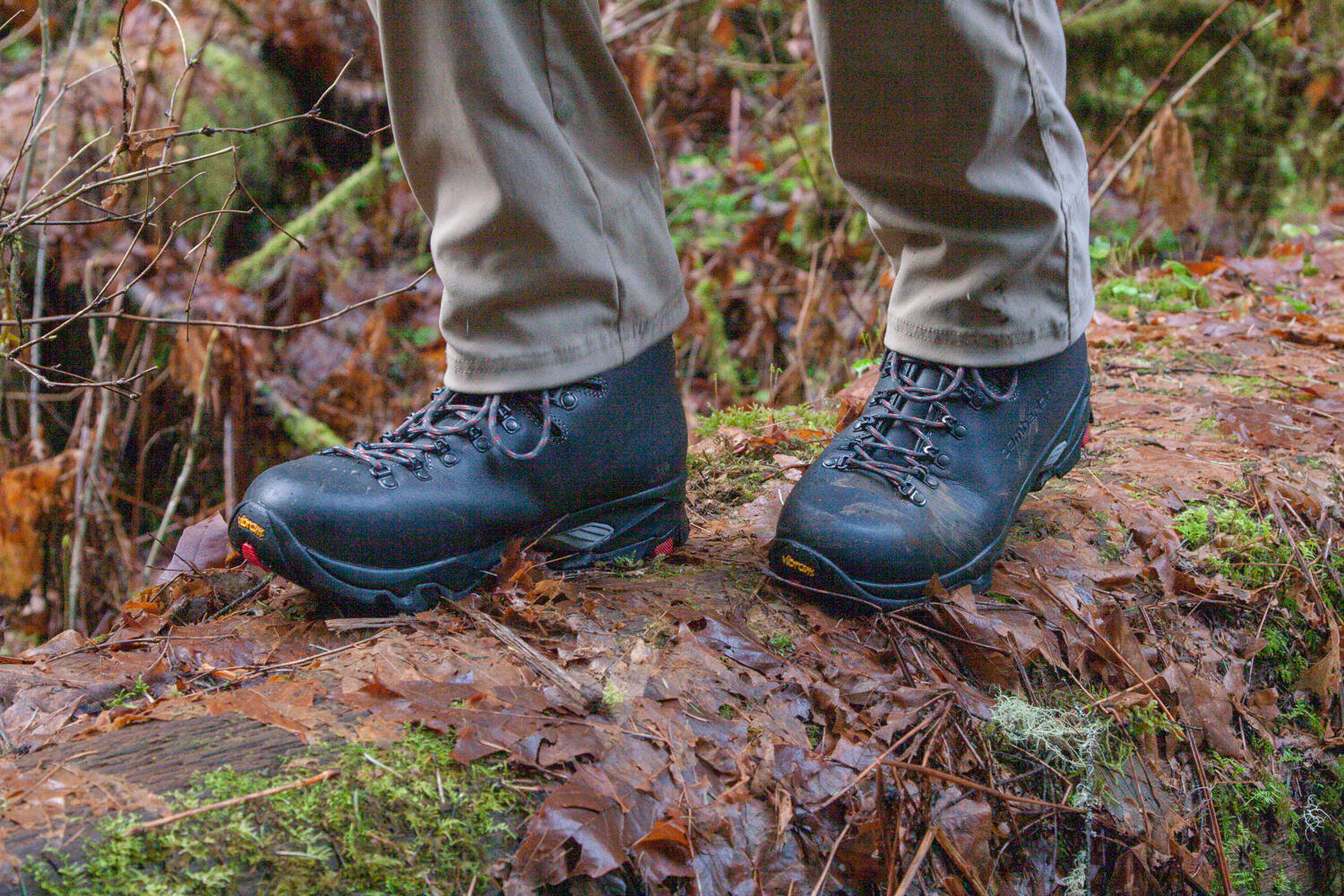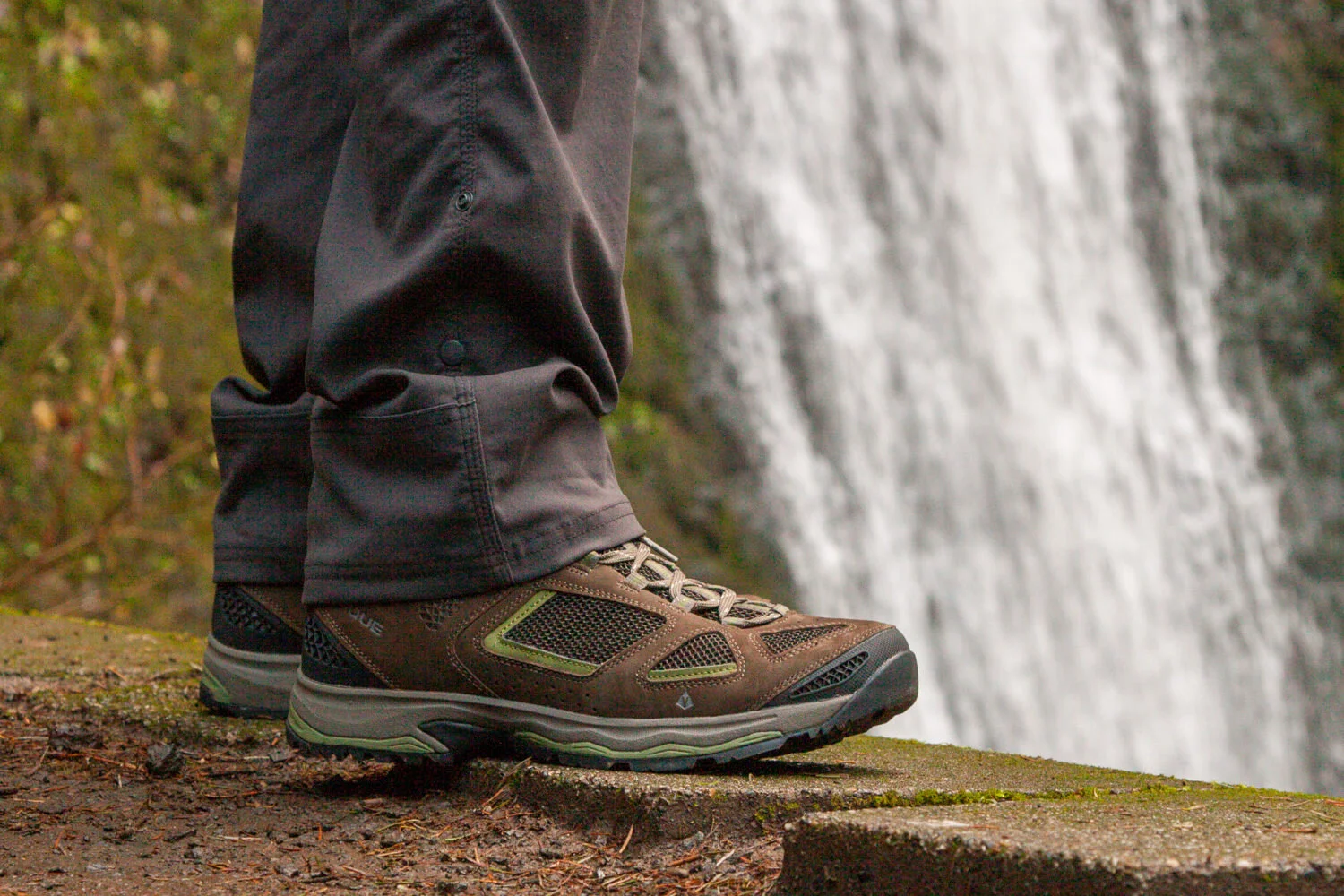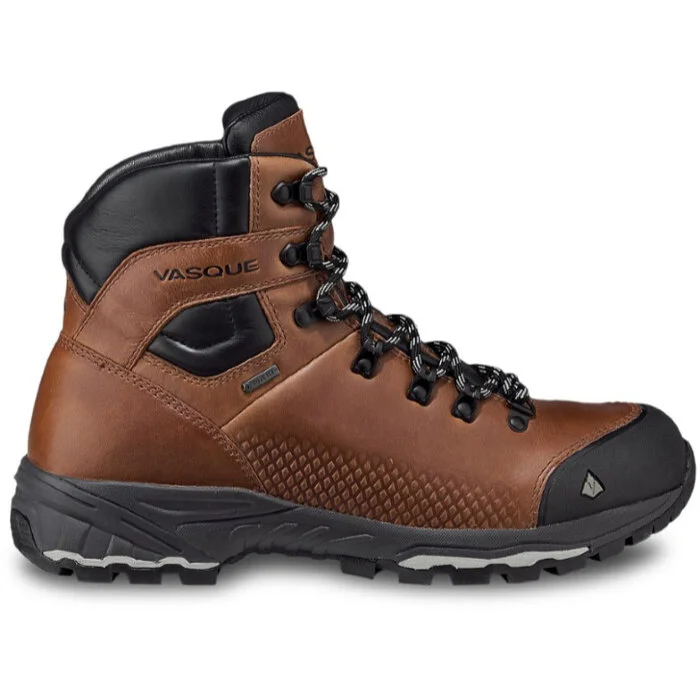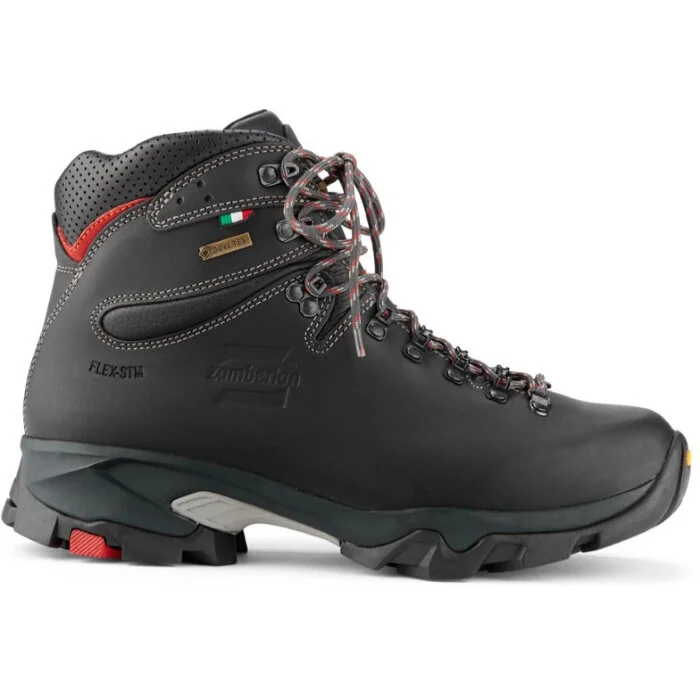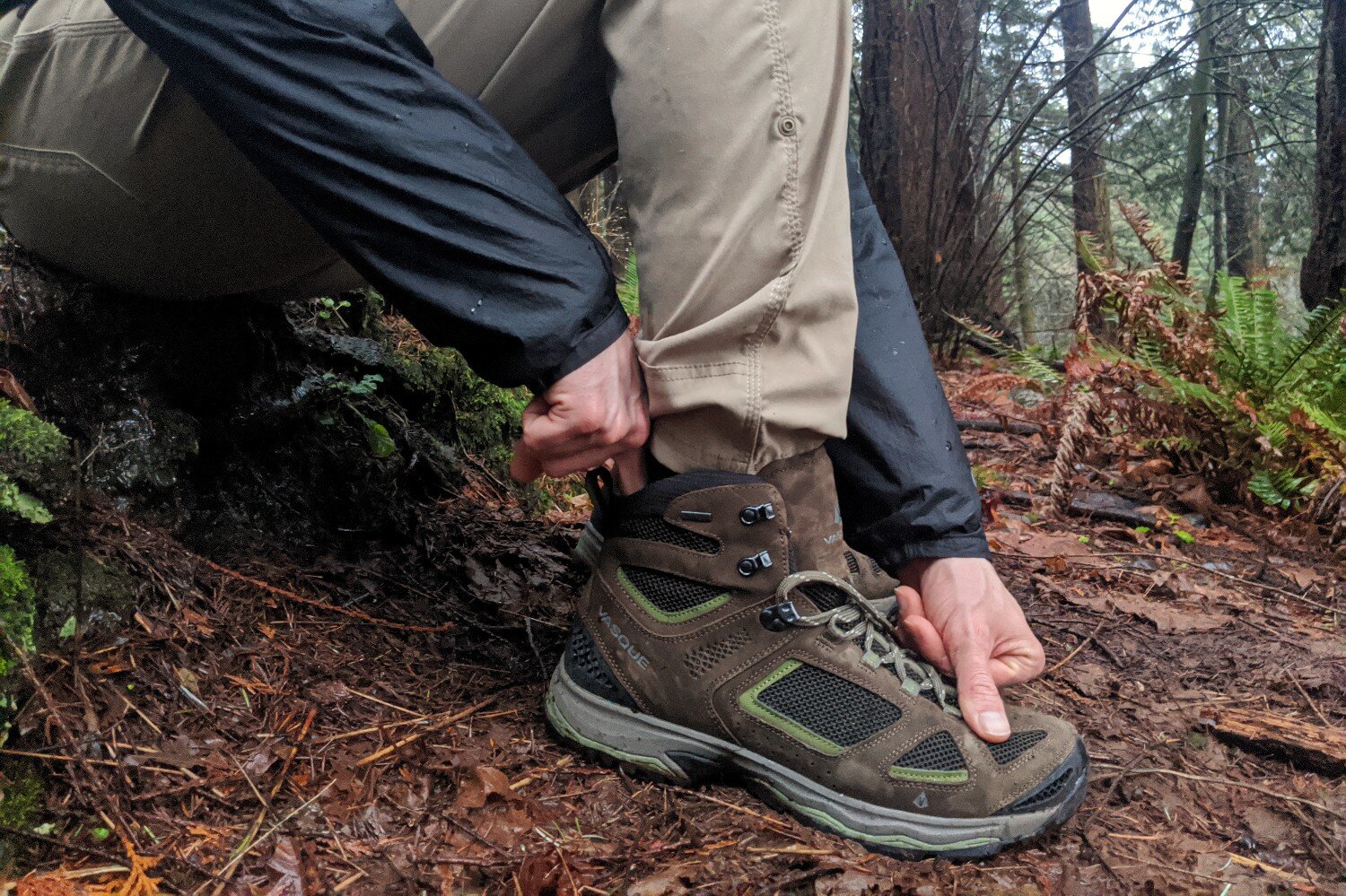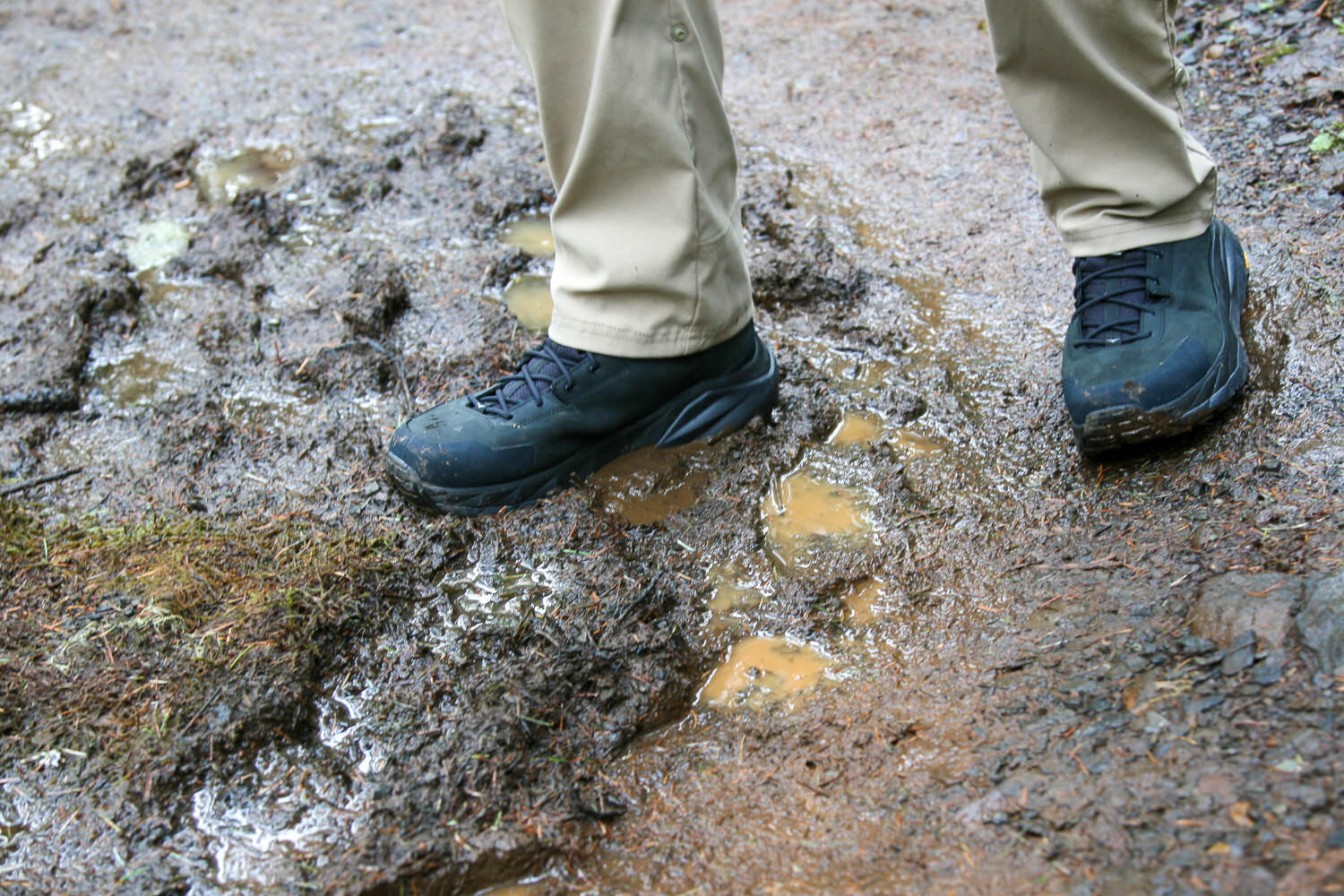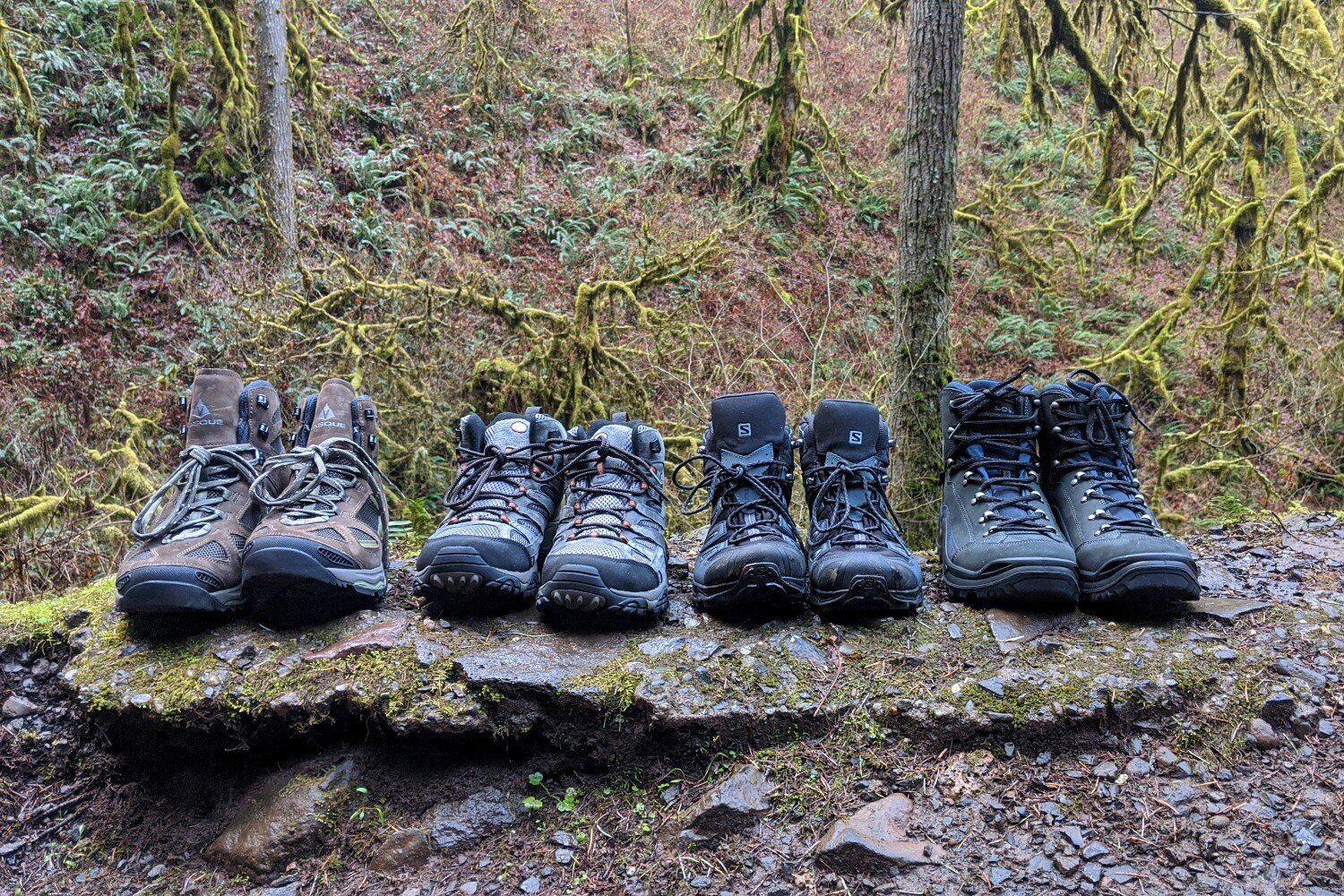PHOTO CREDIT: HEATHER ELDRIDGE (CLEVERHIKER.COM)
Author: Casey Handley | Tester & Editor: Dave Collins
Last Updated: June 8, 2023
We tend to prefer light and breathable shoes for most of our summer hikes, but hiking boots have a solid place in our gear repertoire. Hiking boots offer greater durability than a lot of other footwear for long-term use, better weather protection for cold/wet conditions, and provide more support for rugged off-trail terrain.
Our team of experts tests and analyzes gear full-time. In this guide, we’ll use our on-trail experience to make it easy for you to find the best hiking boots for your needs.
Related: Best Hiking Boots for Women
Salomon X Ultra 4 GTX - PHOTO CREDIT: HEATHER ELDRIDGE (CLEVERHIKER.COM)
Quick Recommendations
Check out this quick list of the best hiking boots, or continue scrolling to see our full list of favorites with in-depth reviews.
Best hiking boots overall: Salomon Quest 4 GTX
Best lightweight hiking boots: Salomon X Ultra 4 GTX
Best hiking boots for backpacking with a heavy load: Lowa Renegade GTX
Best budget hiking boots: Vasque Breeze
Affordable & breathable hiking boots: Merrell Moab 3 GTX
Sturdy, lightweight boots with great traction: La Sportiva Nucleo High II GTX
Best wide-fit hiking boots: KEEN Targhee III WP
Best minimalist hiking boots: Altra Lone Peak ALL-WTHR 2
Durable hiking boots with great support & stability: Vasque St. Elias GTX
Heavy-duty & rugged boots with a high-quality build: Zamberlan Vioz GTX
Budget-friendly hiking boots for casual hikes: Timberland Mt. Maddsen WP
La Sportiva Nucleo High II GTX - PHOTO CREDIT: CASEY HANDLEY (CLEVERHIKER.COM)
What’s Most Important to You in a Hiking Boot?
COMFORT & FIT - Fit is very personal, so what works for some people may not be the best option for others. In general the most comfortable hiking boots give your toes some room to spread, have cushioning that supports your foot shape, and have some flex in the upper so it moves with your foot.
Hiking boots that don’t require much breaking in to be comfortable: Vasque Breeze, Salomon X Ultra 4, Altra Lone Peak ALL-WTHR 2, Merrell Moab 3 & La Sportiva Nucleo High II
Best hiking boots with a wide fit: Merrell Moab 3, KEEN Targhee III & Altra Lone Peak ALL-WTHR 2
Most supportive hiking boots: Salomon Quest 4 GTX, Lowa Renegade GTX, La Sportiva Nucleo High II GTX, Vasque St. Elias GTX & Zamberlan Vioz GTX
KEEN Targhee III - PHOTO CREDIT: CASEY HANDLEY (CLEVERHIKER.COM)
PRICE - High-quality footwear can be expensive, but we’re usually willing to spring for it because the success of our adventures depends on having happy, healthy feet. Cheap footwear tends to be less breathable, falls apart easily, and is more likely to create blisters and other foot problems. We recommend spending a bit more if you’re able as it will be cheaper than replacing blown out and ill-fitting boots in the long run. You can expect quality craftmanship and performance from all of the hiking boots on this list.
Best value hiking boots: Salomon X Ultra 4 & KEEN Targhee III
Best budget hiking boots: Vasque Breeze, Merrell Moab 3 & Timberland Mt. Maddsen
Best high-end hiking boots: Salomon Quest 4, Lowa Renegade, La Sportiva Nucleo High II & Zamberlan Vioz
Merrell Moabs - PHOTO CREDIT: HEATHER ELDRIDGE (CLEVERHIKER.COM)
WEIGHT - Weight on your feet zaps about 5 times more energy than weight carried on your back. Lighter hiking boots mean less muscle fatigue, less stumbling, and they can help avoid knee and hip flexor problems. That’s not to say that heavier boots are bad though. If you do a lot of hiking off-trail or you tend to carry a heavier pack, you may want to go with a more burly and durable boot.
Best ultralight hiking boots: Altra Lone Peak ALL-WTHR 2, Salomon X Ultra 4 GTX & Vasque Breeze LT NTX
Best lightweight hiking boots: La Sportiva Nucleo High II, KEEN Targhee III & Merrell Moab 3 GTX
Best heavy-duty hiking boots: Lowa Renegade, Vasque Breeze, Salomon Quest 4 GTX, Vasque St. Elias GTX & Zamberlan Vioz
Altra Lone Peaks - PHOTO CREDIT: CASEY HANDLEY (CLEVERHIKER.COM)
ANKLE SUPPORT - Most research says that if you want to prevent ankle injuries, you should focus on strengthening and stretching your ankles. That said, boots with more ankle support can help prevent rolled ankles and they sit higher up to better keep water out. For hikers looking for the added support, you should pick a boot that sits higher up on the ankle and be sure to tie the laces tightly.
Hiking boots with the best ankle support: Salomon Quest 4, Lowa Renegade, Zamberlan Vioz, Vasque St. Elias & La Sportiva Nucleo High II GTX
Salomon Quest 4 - PHOTO CREDIT: HEATHER ELDRIDGE (CLEVERHIKER.COM)
DURABILITY & MATERIALS - Hiking boots can be a big investment, so finding a durable pair will help you get the most bang for your buck. Traditional leather hiking boots are almost always going to be more durable than lightweight footwear. But if keeping weight low is important to you, look for a pair of hiking boots with reinforced mesh in the construction to get the best balance of weight and durability.
Most durable hiking boots: Salomon Quest 4, Lowa Renegade, Vasque Breeze & Zamberlan Vioz
Boots with the best balance of weight & durability: Salomon X Ultra 4 GTX, La Sportiva Nucleo High II GTX & Merrell Moab 3 GTX
Zamberlan Vioz - PHOTO CREDIT: HEATHER ELDRIDGE (CLEVERHIKER.COM)
WATERPROOF VS NON-WATERPROOF - Some of the boots on this list come in both waterproof and non-waterproof versions.
Waterproof hiking boots can be a real lifesaver if you often hike in wet, muddy areas. We like using them for muddy day hikes in shoulder seasons and in the snow during winter. That said, waterproof boots aren’t very breathable so they can be a bit stuffy on hot days. They can also get heavy and be slow to dry when they get wet.
Non-waterproof hiking boots are lighter and more breathable, and though they’re susceptible to getting wet, they dry fairly quickly. For occasions where we’d choose boots, we usually reach for waterproof ones. But if you do most of your hiking in the drier months, you’ll probably be more comfortable with non-waterproof.
Best waterproof hiking boots: Salomon Quest 4, Salomon X Ultra 4, Lowa Renegade GTX, Vasque Breeze, Merrell Moab 3 GTX, La Sportiva Nucleo High II GTX & KEEN Targhee III WP
Best non-waterproof hiking boots: Merrell Moab 3, KEEN Targhee Vent & Altra Lone Peak Hiker 2
Vasque Breeze - PHOTO CREDIT: HEATHER ELDRIDGE (CLEVERHIKER.COM)
Sortable Hiking Boots Comparison Table
| Hiking Boot | Price | Weight/Pair | Support Level |
|---|---|---|---|
| 1. Salomon Quest 4 GTX | $230 | 46.4 oz. | High |
| 2. Salomon X Ultra 4 GTX | $175 | 30.0 oz. | Medium |
| 3. Lowa Renegade GTX | $255 | 39.0 oz. | High |
| 4. Vasque Breeze | $160 | 40.0 oz. | Medium |
| 5. Merrell Moab 3 GTX | $165 | 35.0 oz. | Medium |
| 6. La Sportiva Nucleo High II GTX | $239 | 33.0 oz. | Medium |
| 7. KEEN Targhee III WP | $175 | 34.8 oz. | Medium |
| 8. Altra Lone Peak ALL-WTHR 2 | $190 | 30.0 oz. | Low |
| 9. Vasque St. Elias GTX | $230 | 55.0 oz. | High |
| 10. Zamberlan Vioz GTX | $350 | 68.8 oz. | High |
| 11. Timberland Mt. Maddsen WP | $120 | 34.0 oz. | Medium |
Best Hiking Boots of 2023
BEST HIKING BOOTS OVERALL
MSRP: $230
WEIGHT (PAIR): 3 lb. 4.2 oz.
SIZING: True to size
PROS: Excellent ankle support, stable, durable, excellent traction, supportive soles, good for backpacking with a heavier load
CONS: Heavier than some, require some break-in
BOTTOM LINE: The Salomon Quest 4 GTX offer some of the most robust ankle support of any of the hiking boots on our list, so they’re a great choice for hikers wanting maximum stability. Their durable materials and aggressive traction - in combination with that supportive design - will keep you moving confidently on the most rugged terrain.
These boots are on the heavier side, but that can be a benefit if you tend to hike with a backpack that’s 40 lbs. and above. More burly hiking boots like the Quests won’t lose their support under a heavier load like lightweight footwear does. And the Quests still feel more nimble than the other more traditional boots on our list thanks to their well-balanced design.
The Quests come at a high price, but they’re very worth the cost as you’ll be getting a solid pair of hiking boots that will remain comfortable and supportive over thousands of miles.
BEST LIGHTWEIGHT HIKING BOOTS
MSRP: $175
WEIGHT (PAIR): 2 lbs. 6 oz.
SIZING: True to size; wide sizes available
PROS: No break-in needed, excellent traction, ultralight, durable, stable, good for lightweight backpacking
CONS: Less ankle support than some
BOTTOM LINE: Comfort is the name of the game with the Salomon X Ultra 4 GTX boots. They’re flexible, they feel great right out of the box, and they’re exceptionally lightweight for boots, so they’re an excellent choice for backpackers who keep their pack weight around 35 lbs. or under.
The X Ultras aren’t as supportive as the burlier models on this list, but they’ll feel like a dream for those looking for the best balance of protection and cushioning. And while the flexible collar allows for more movement around the ankle, the wing at the midfoot still provides stability for confidence on uneven terrain.
Overall, we’re very impressed with the X Ultras, and we highly recommend them for anyone wanting a lightweight hiking boot that’s comfy enough for long distances with a lighter load.
BEST HIKING BOOTS FOR BACKPACKING WITH A HEAVY LOAD
MSRP: $255
WEIGHT (PAIR): 3 lb. 1.9 oz.
SIZING: True to size; available in narrow & wide sizes
PROS: Supportive, durable, excellent traction, stable, excellent ankle support, stylish, good for backpacking with a heavier load
CONS: Heavier than some, expensive, require longer break-in period
BOTTOM LINE: The Lowa Renegade GTX is a wildly popular boot that offers nearly unmatched durability and foot protection for hikers who regularly tackle tough terrain with a heavier load.
The Renegades come in at a steep price, but their exceptional durability make them well worth the cost since you won’t need to buy another pair of boots for a good long while. We often find that boots with this level of support can feel a bit restrictive, but that’s not the case with the Renegades. These boots are quite comfortable to wear for long periods after some breaking-in.
If top-tier ankle support and stability are what you’re after, the Lowa Renegades deliver in spades. And of course it doesn’t hurt that they look great while doing it.
HIGHLY BREATHABLE WATERPROOF HIKING BOOTS
MSRP: $160
WEIGHT (PAIR): 3 lb. 0.5 oz.
OPTIONS: Breeze LT NTX (lightweight version)
SIZING: True to size; wide sizes available
PROS: Affordable, breathable, durable, supportive, excellent traction, very little break-in required, stable
CONS: Heavier than some
BOTTOM LINE: The Vasque Breeze has returned due to popular demand, and the latest iteration puts a fresh spin on the tried-and-true original design. The newest Breeze is made with recycled materials and sports a more affordable price than previous versions.
What really stands out about the Breeze compared to other hiking boots is how breathable they are for waterproof footwear. Mesh panels throughout the boots help your feet thermoregulate and allow them to dry faster when they get wet. These boots are also comfortable right out of the box - they require very little break-in since they’re lightweight and flexible.
With so much goodness at such an approachable price, we expect to see a ton of Breeze boots out on the trails for years to come. If you’re looking to go a little lighter, we also like the LT Version which weighs about 50% less.
AFFORDABLE & BREATHABLE HIKING BOOTS
MSRP: $165
WEIGHT (PAIR): 2 lb. 10.5 oz.
OPTIONS: Non-waterproof
SIZING: True to size; runs a little wide/high-volume & wider sizes are available
PROS: Affordable, very little break-in required, durable, breathable
CONS: Not as supportive as some, a bit bulky
BOTTOM LINE: Don’t mistake the low price of the Merrell Moab 3 GTXs to mean lower quality. These tried-and-true hiking boots have reigned as the top choice for budget-conscious hikers for as long as we can remember.
The Moabs are our top recommendation if you’re after a midweight boot for day hiking. They’re comfortable, durable, they require very little break-in before they’re trail-ready, and they’re decently breathable for waterproof boots.
Because they feel a little more bulky than some of our lightweight favorites, they aren’t our first choice for big-mile days. But they’ll last a long time, and they’re some of our go-tos for day hikes and weekend trips when the weather and trail call for more protection than a hiking shoe can offer.
STURDY, LIGHTWEIGHT BOOTS WITH GREAT TRACTION
MSRP: $239
WEIGHT (PAIR): 2 lbs. 8.5 oz.
SIZING: True to size, fits a little narrow; wide sizes available
PROS: Excellent traction, very lightweight for how rugged they are, breathable, good ankle support, durable, stylish, good for lightweight backpacking
CONS: Require some break-in, expensive
BOTTOM LINE: Hikers who frequently tackle tough terrain will appreciate the above-average traction and lightweight support of the La Sportiva Nucleo High II GTX boots. The Nucleos are exceptionally lightweight for how durable they are, and they’re decently breathable for waterproof boots.
The high collar of the Nucleos provides ample ankle support, but their low weight keeps them feeling nimble and comfy enough for all-day wear. Whether you’re hitting the trail for a multi-day hike or just heading out for the day, these stylish boots are ready for adventure.
The upper and soles are somewhat stiff, so you may want to add aftermarket insoles if you prefer a soft, cushioned feeling underfoot. But overall, we find the Nucleos extremely comfortable and highly recommend them for hikers looking for a boot with a good balance of traditional boot burliness and modern footwear low weight.
BEST WIDE-FIT HIKING BOOTS
MSRP: $175
WEIGHT (PAIR): 2 lb. 8.9 oz.
OPTIONS: Non-waterproof
SIZING: True to size; runs a little wide/high-volume & wider sizes are available
PROS: Excellent traction, very little break-in required, very beefy toe cap, secure fit
CONS: Less supportive at the ankle than other boots, less durable than some
BOTTOM LINE: If you like a boot with a little extra wiggle room in the toe, the KEEN Targhee III Mid WP may be just the right fit. They’re designed with an extra wide toe box - wider sizes are also available - and they require very little break-in to achieve a comfy-all-day fit.
The lacing system on the Targhees includes a unique band that attaches behind the heel to provide a secure, locked-in feeling that helps with stability on uneven terrain. And the varied lug pattern on the sole provides superb traction on all manner of trail.
Those who like a lot of ankle support will probably find them to be a little less protective than other boots on this list, but we view them as a good balance between support and flexibility. Overall, hikers looking for a wide-fitting boot at a great value price won’t be disappointed by the Targhees.
BEST MINIMALIST HIKING BOOTS
MSRP: $190
WEIGHT (PAIR): 1 lb. 14.4 oz.
OPTIONS: Non-waterproof
SIZING: True to size: wide toe box
PROS: Ultralight, wide toe box, no break-in required, flexible, excellent traction, good for lightweight backpacking
CONS: Less durable than some (waterproof membrane wears out quicker than others), less supportive than others
BOTTOM LINE: The Altra Lone Peak ALL-WTHR Mids are much lighter and less bulky than traditional boots. So they’re perfect for hikers and backpackers who are after the extra protection and waterproofing of a boot without the need for burly support.
The waterproof layer is an eVent membrane which is a bit more breathable than the more common GORE-TEX, but it’s not quite as durable. That said, we find the flexibility and low weight of the Lone Peaks to be well worth that tradeoff when we’re logging lots of miles.
The latest iteration of these shoes is more supportive than previous models, but the Lone Peaks offer a lower level of support overall than some of the beefier boots on our list. For fast and light adventures that call for more protection than a trail runner can provide, the Lone Peaks can’t be beat.
DURABLE HIKING BOOTS WITH GREAT SUPPORT & STABILITY
MSRP: $230
WEIGHT (PAIR): 3 lb. 7 oz.
SIZING: True to size; wide sizes available
PROS: Supportive, durable, excellent traction, excellent ankle support, stable, very beefy toe cap, stylish, good for backpacking with a heavier load
CONS: Heavier than some, expensive, stiff, require longer break-in period
BOTTOM LINE: The classic look of the Vasque St. Elias GTX boots is backed up by the tried-and-true durability of their traditional leather build. The ankle cuff provides ample support and the stout toe cap gives great protection for tackling trails with a lot of rocks and roots.
Like many other traditional boots, the St. Elias are more stiff than lighter options. But once they loosen up a bit, you’ll have a bomb-proof, high-quality hiking boot that will look great, feel comfy, and perform well for years to come. Still, much of that stiffness will remain to help provide stability on technical trails.
When it comes to durability and support, the Vasque St. Elias is a leader in the boot market. Choose this hiking boot if you tend to carry heavier loads around 40 lbs. or more on rough paths and off-trail routes.
HEAVY-DUTY BOOTS WITH A HIGH-QUALITY BUILD
MSRP: $350
WEIGHT (PAIR): 4 lb. 4.8 oz.
SIZING: True to size; wide sizes available
PROS: High-quality materials & construction, excellent traction, excellent ankle support, durable
CONS: Expensive, heavy, stiff, require longer break-in period
BOTTOM LINE: You’ve likely noticed that the Zamberlan Vioz GTX come with a very steep price tag, but are they worth it? We say definitively yes, as very few hiking boots can compete with the quality build and durability of the Vioz. These boots are made for hikers looking for the the beefiest support, the most stable ride, and the most protective build.
Though they’re built like a tank and the heaviest boots on our list, we’ve been surprised by how comfortable the Vioz are. That said, the full-grain leather upper requires more breaking-in than other hiking boots before they can fully shine.
Hikers who need a serious boot that can withstand the toughest of terrain will quickly learn that the high cost of the Zamberlan Vioz is worth every penny for the thousands of miles they’ll get out of these boots.
BUDGET-FRIENDLY HIKING BOOTS FOR CASUAL HIKES
MSRP: $120 (often on sale for less)
WEIGHT (PAIR): 2 lb. 7.6 oz.
SIZING: Runs a bit large
PROS: Affordable, lightweight
CONS: Stiff upper, require longer break-in period, less durable than some
BOTTOM LINE: If you’re on a tight budget and itching to hit the trail, the Timberland Mt. Maddsen WP are the most budget-friendly hiking boots on our list.
The Mt. Maddsens feature a classic, all-leather look and they’re reasonably lightweight, but we’d be lying if we said these boots were comfortable enough for long days on trail. They’re stiff and the toe box caused some irritation at first, but that did subside quite a bit after some use. We recommend thoroughly breaking them in before any big hikes.
While the Mt Maddsens aren’t our top recommendation, we felt they still deserved a shoutout on our list because the friendly price point is perfect for getting you on the trail when the budget is tight. We typically find it more practical to spend a little more for footwear that will last longer, but the Mt. Maddsens perform well and are still a solid choice if you need to save some bucks.
PHOTO CREDIT: HEATHER ELDRIDGE (CLEVERHIKER.COM)
Honorable Mentions
The following hiking boots didn’t make our final list, but they’re very popular, and they’ve still got a lot of good things going for them. You never know, one of these pairs of boots might be your perfect fit:
HOKA Kaha 2 GTX - These trail runner hybrids have thick, springy soles that help absorb shock and provide resilience on rough terrain. The Kahas have standout traction and breathability, but those looking for a super stable boot may not like them due to the minimal ankle support and taller stack height.
Asolo Fugitive GTX - The Asolo Fugitives are breathable boots that offer ample protection. They’re known for their high-quality materials and construction, but that comes with a high price tag.
Danner Mountain 600 Mid WP - These midweight hiking boots have iconic style. They’re known for exceptional durability, but we didn’t feel they stood out in performance categories.
Scarpa Zodiac Plus GTX - The Scarpa Zodiac Plus are a hybrid of hiking/mountaineering/approach boots. They excel on the most technical of terrain, but they’re overkill for most hikers’ needs.
PHOTO CREDIT: HEATHER ELDRIDGE (CLEVERHIKER.COM)
Critical Footwear Considerations
BOOTS VS. SHOES VS. TRAIL RUNNERS - Hiking footwear is a really personal choice, and people often have differing opinions on what type of shoe works best for hiking. We tend to prefer lightweight trail runners since they’re more comfortable to hike long distances in and they’re typically more breathable. Traditional hiking boots - especially those made with leather - are going to be more durable, but they’re typically significantly heavier/bulkier. Here’s an article that will help you decide which style works best for you.
SIZING - Feet can swell during long days on the trail, so it’s good to buy hiking footwear at least a half size larger than your normal shoes. A good way to test sizing on your boots is to loosen all the laces, situate your foot so that your toes touch the front of the toe box, and then make sure you can put your index finger between your heel and the back of the boot. This will ensure that your toes don’t slide forward and hit the toe box on downhill sections of trail. You should also consider which socks you’ll be wearing and if you’ll be adding aftermarket insoles when choosing a size. It’s much better for footwear to be a little big than too small.
Vasque Breeze - PHOTO CREDIT: CASEY HANDLEY (CLEVERHIKER.COM)
BREAK-IN PERIOD - You’re going to take thousands of steps on any backpacking or hiking trip, so you need to know that your footwear will fit comfortably and won’t cause blisters. We recommend buying your footwear at least a few weeks before any long hiking trips and spending as much time in them as you can. This will allow your new hiking boots to soften up, and you can make sure they work well for your feet. If you notice any issues, it’s much easier to address them before you head into the backcountry.
TRACTION - Traction is one of the most important aspects of backpacking and hiking footwear. Your hiking boots will take you over narrow and rocky ridgelines, through slippery water crossings, and across loose scree fields. Knowing that your footwear will keep you from slipping is crucial, especially over washed out or exposed sections of trail. We heavily factored quality traction into all of our footwear recommendations.
Zamberlan Vioz, Vasque Breeze, Altra Lone Peak & KEEN Targhee III - PHOTO CREDIT: CASEY HANDLEY (CLEVERHIKER.COM)
MANAGING MOISTURE & BLISTERS - If you’re on an extended trip with lots of water crossings or hiking in persistently wet conditions, your feet will likely get wet whether your footwear is waterproof or not. Wet feet can lead to hot spots and blisters, so it's critical to know how to manage moisture, prevent, and treat blisters.
WATERPROOFING TREATMENTS - Waterproof footwear is ideal for soggy day hikes, but it’s important to remember that “waterproof” doesn’t mean that water can never get in. Water will always find a way in during a prolonged downpour and light rain can drip down your legs and into the top of your boots. Even the highest quality boots will develop small holes that allow moisture to creep in over time. Waterproof treatments are not permanent, you’ll eventually need to reapply a treatment to keep your hiking boots sealed.
Zamberlan Vioz GTX - PHOTO CREDIT: HEATHER ELDRIDGE (CLEVERHIKER.COM)
SOCKS - We’ve found that wearing quality socks makes a big difference in how long we can keep our feet happy and in good shape on trail. Hiking socks should be comfortable, durable, and made with materials that wick moisture away from your skin. Check out our Best Hiking Socks list to see our top picks.
INSOLES - Aftermarket insoles can help alleviate a variety of shoe discomforts on the trail. If you suffer from plantar fasciitis or you just need more cushioning and support in an otherwise rigid shoe, swapping insoles may be your solution. Insoles can also help take up a little extra space in footwear for a customized fit if you’re between sizes.
AFTERMARKET INSOLES - PHOTO CREDIT: CASEY HANDLEY (CLEVERHIKER.COM)
Need More Gear Advice?
If you liked this list, you’ll love the CleverHiker Gear Guide where we test and recommend tons of outdoor adventure gear from a variety of categories. here are some links to popular articles:
Vasque Breeze - PHOTO CREDIT: CASEY HANDLEY (CLEVERHIKER.COM)
Why Trust Us?
We fully understand how tough it is to find trustworthy gear advice, and that’s one of the main reasons we built CleverHiker. We live for outdoor adventure, and we take these guides very seriously. Here are some of the reasons you can trust us:
Our choices are completely independent and based on personal experience.
We’ve logged over 10,000 trail miles and test outdoor gear for a living.
We own and field test every product we recommend, which is sadly not the norm.
We travel to industry trade shows to learn about upcoming product innovations.
We constantly update our guides when new products launch.
We treat our recommendations as if they were for our family and friends.
We’re lifelong learners and we’re always open to constructive criticism. If you think we’ve missed a product or got something wrong, we’d love to hear your feedback.
PHOTO CREDIT: HEATHER ELDRIDGE (CLEVERHIKER.COM)
More Information
We hope this guide helps you find the perfect gear for your needs. If you have more questions or a suggestion, we’d love to hear from you! Sign up for our newsletter to stay updated on our latest posts then visit our Facebook page and Instagram to join the community conversation.
If you found this guide helpful, please give it a share on social media! Also, be sure to check out our CleverHiker Gear Guide to see all of our top gear picks.
Thanks for reading and happy trails!
Some of the links on this page are affiliate links, which means we may receive a modest commission if purchases are made through those links. This adds no cost to our readers and helps us keep our site up and running. Our reputation is our most important asset, which is why we only provide completely honest and unbiased recommendations.

